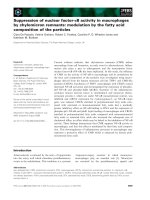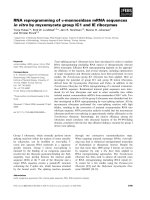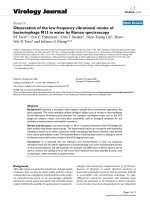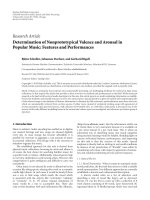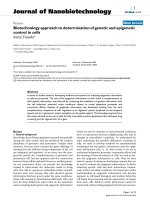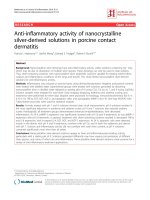Determination of the viscosities of aqueous polyethylene glycol solutions in water by Ostwald viscometer
Bạn đang xem bản rút gọn của tài liệu. Xem và tải ngay bản đầy đủ của tài liệu tại đây (36.63 KB, 4 trang )
Determination of the viscosities of aqueous polyethylene
glycol solutions in water by Ostwald viscometer.
Full name: Tran Thi Thu Tra
Student ID: 20191129
Instructor:
Date of submission: 05/09/2022
I. Introduction.
One of the most significant factors to describe a fluid is its viscosity, which is a
measurement of how much resistance is encountered when moving an object
through it. In fluid dynamics, viscosity is an important parameter. [1]
This experiment's research method is to examine the flow of the solution via the
capillary naturally. The viscosities of aqueous polyethylene glycol solutions in
water depend on the concentration of aqueous polyethylene glycol solutions in
water.[2]
This experiment showed the progressive relationship between the viscosities of
aqueous polyethylene glycol solutions in water with the C% mass of polyethylene
glycol. Due to this progressive relationship, the purpose of the experiment was
determined. The experiment aimed to determine the viscosities of aqueous
polyethylene glycol solutions in water by Ostwald viscometer. This experiment
hypothesizes that in the small concentration range of aqueous polyethylene glycol,
the concentration of aqueous polyethylene glycol solutions increased, and the
viscosities of aqueous polyethylene glycol solutions would be increased.[2]
II. Methodology
The viscosities were measured by Ostwald viscometer (China, 220mm). Ostwald
viscometer was cleaned and rinsed by a wash bottle. Ostwald viscosity was rinsed
with pure water three times before carrying out. Ostwald viscometer was put in the
thermostat which was 22oC. Pure water was transferred 10ml into tube 1 of the
viscometer by the pipette (China, 20ml;0.1ml). The rubber bulb (Bio BasicCanada, 60 ml) was put into tube 1 of the viscometer to blow slowly pure water
over the line a was approximately 1cm. Pure water was still at the bulb of tube 1 of
the viscometer. Each experiment was waited about five minutes to be stable the
temperature of pure water after conducting to measure. The experiment will be
carried out. Pure water flowed naturally. The stopwatch counted the time when the
liquid flowed from line a to line b tube 2 of the viscometer. The time was
determined. The experiment was run three times, and the average result was used.
The viscosity of polyethylene glycol solutions was measured similarly. Ostwald
viscometer was cleaned and rinsed with polyethylene glycol solutions three times.
The experiment was conducted with c= 5;8;10;15;20;25% mass of polyethylene
glycol in water. The experiment was conducted from low concentration to high
concentration of polyethylene glycol solutions. Ostwald viscometer was put in the
thermostat which was 22oC. Each experiment waited about five minutes to be
stable the temperature of polyethylene glycol solutions. The time of polyethylene
glycols was counted by the stopwatch. After each experiment, the Ostwald
viscometer was rinsed by the next polyethylene glycol solutions to measure.
When a liquid was put into the capillary, its viscosity was directly proportional to
the flow time t and density ρ, and the viscosity of a liquid was calculated:
η=k.ρ.t
(1)
with k: viscometer
constant
The time of distilled water flowed to determine the viscometer constant at the same
temperature and liquid volume.
ηo=k.ρo.to
(2)
with ηo: viscosity of the distilled water
to the time of distilled water flowed from the line a to the line b
η/ηo=ρ.t/ρo.to
η=ηo. ρ.t/ρo.to
A liquid had a low concentration, with ρ=рo:
η=ηo. t/to
The characteristic viscosity was determined:
η=(η-ηo)/ ηo =η/ηo-1=t/to-1
III. Result
Figure 2 shows the progressive relationship between the viscosities of aqueous
polyethylene glycol solutions in water with the C% mass of polyethylene glycol.
The dependency diagram shortened viscosity on C% quality is an inverted straight
line and fits a quadratic trendline: y= 0.1459x + 2.726 with an R2 of 0.9926. The
characteristic viscosity of polyethylene glycol in water is 2.73 m. N.s/m2.
Figure 2. The shortened viscosity of aqueous polyethylene glycol solutions in
water
IV. Discussion
The relationship between the viscosities and mass of aqueous polyethylene glycol
in water was progressive at the same time. The relationship between the viscosities
of aqueous polyethylene glycol solutions in water and the C% mass of
polyethylene glycol was calculated and determined. The characteristic viscosity of
aqueous polyethylene glycol solutions in water is 2.73 m. N.s/m2.
In the small concentration range of aqueous polyethylene glycol, the concentration
and the viscosities of aqueous polyethylene glycol solutions increased at the same
time. When the concentration of aqueous polyethylene glycol solutions increased
with c= 5;8;10;15;20;25% mass of polyethylene glycol in water, the viscosities of
aqueous polyethylene glycol increased. These findings demonstrate that the
number of aqueous polyethylene glycol viscosities has significantly increased:5%
mass of polyethylene glycol, the viscosity is 1.131 m. N.s/m2; c= 25% mass of
polyethylene glycol, the viscosity is 2.470 m. N.s/m 2. The viscosities of aqueous
polyethylene glycol solutions increased two times after increasing the
concentration of aqueous polyethylene glycol solutions.
Despite the fact that there is still space for error in our results owing to a variety of
factors: instrumental error, temperature error, and calculation error. So, the
measurement result has errors.
V. Conclusion
The relationship between the viscosities and mass of aqueous polyethylene glycol
in water was progressive at the same time. The characteristic viscosity of aqueous
polyethylene glycol solutions in water is 2.73 m. N.s/m2. In the small
concentration range of aqueous polyethylene glycol, the concentration and the
viscosities of aqueous polyethylene glycol solutions increased. This experiment
had some errors: instrument error, temperature error, and calculation error. The
instrument should be replaced with one from the stockroom to fix the issue.
REFERENCES
[1] Kopeliovich, Dmitri, “Effect of Oil Viscosity on Hydrodynamic Friction of
Engine Bearings.” SubsTech Substance and Technologies, 3 Feb. 2018.
[2] Cao Hong Ha et. al., Thi Nghiem Hoa ly [Physical chemistry laboratory
manual], (in Vietnamese). Nha xuat ban Bach Khoa Ha Noi, 2020.
APPENDIX. Raw and Processed Experimental Data
Table 1. Raw and processed of the viscosities of aqueous polyethylene glycol in
water.
Mass of
polythylene
glycol in
water(C%)
t(s)
5
34.59
1.131
0.177
3.54
8
38.47
1.258
0.309
3.86
10
41.30
1.351
0.406
4.06
15
50.88
1.664
0.732
4.88
20
63.66
2.082
1.166
5.84
25
75.52
2.470
1.570
6.28
ᵑ
ᵑr
ᵑr/C
(m. N.s/m2)



